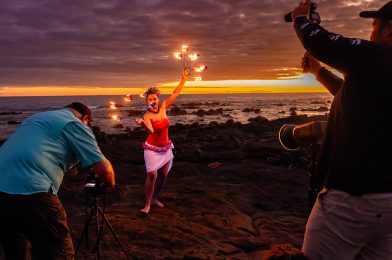Fire Dancer, Aileen Kunewa. Photo by Dorie Griggs [NIKON Z 9, NIKKOR Z 24-120mm f/4 S, Mode = Aperture Priority, ISO 25600, 1/200, ƒ/4.5, (35mm = 24) Processed with PureRAW 4 & Lightroom Classic]
In the ever-evolving landscape of photography, one of the most fundamental aspects has been the sensitivity of film or, in today’s world, the ISO setting in digital cameras. Back in the days of film photography, adjusting ISO meant grappling with the tradeoff between sensitivity and grain. The higher the ISO, the more light-sensitive the film became, but at the cost of introducing noticeable grain into the image.
Fast forward to the digital era, and the concept of ISO underwent a significant transformation. Instead of grain, digital sensors introduced noise as the primary concern with higher ISO settings. However, even in the early days of digital photography, the correlation between ISO and noise wasn’t drastically different from the film days. It was a familiar tradeoff – increased sensitivity at the expense of introducing unwanted noise.
But then came the technological leap. As Moore’s Law applied its magic to camera sensors, the noise performance improved exponentially. Suddenly, higher ISO settings didn’t necessarily equate to unbearable noise levels. With each iteration of camera models, the threshold for acceptable noise is pushed higher and higher. ISO 10000 or even 12800 became feasible options without sacrificing image quality significantly.

The game-changer, however, was the advent of denoise software. Tools like Topaz Denoise, PureRAW, and Lightroom’s denoise capabilities revolutionized post-processing, almost rendering the concept of noise obsolete. What was once a dreaded side effect of high ISO settings became a minor inconvenience easily remedied with a few clicks.
So, what does ISO mean in today’s digital photography landscape? It’s a question that prompts contemplation. The traditional tradeoff between sensitivity and noise has been disrupted. The grain of film and the noise of digital sensors no longer hold the same weight they once did. Instead, adjusting ISO in digital photography is more akin to controlling volume. It’s about amplifying the signal without amplifying the noise.

Yet, amidst this technological marvel, a lingering question remains – what is the tradeoff of ISO today? The answer isn’t as straightforward as it once was. With noise reduction software capable of miraculous feats, the boundaries of acceptable ISO settings blur. Perhaps the tradeoff now lies in the nuances of dynamic range, color accuracy, or subtle details that emerge or diminish with varying ISO levels.
Ultimately, the evolution of ISO from the grainy days of film to the noise-controlled realm of digital photography signifies more than just technological progress. It’s a testament to the ever-changing nature of photography, where what was once a steadfast rule becomes a fluid concept open to interpretation and exploration. And perhaps therein lies the beauty – in the perpetual quest to redefine and refine our understanding of light, sensitivity, and the art of capturing moments frozen in time.

